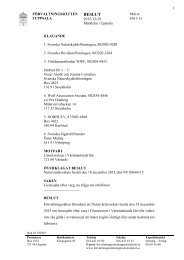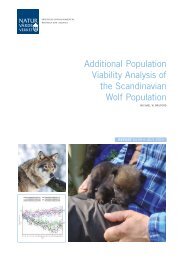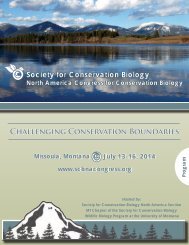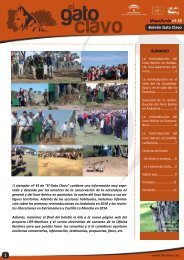1oC3Dbk
1oC3Dbk
1oC3Dbk
Create successful ePaper yourself
Turn your PDF publications into a flip-book with our unique Google optimized e-Paper software.
marine protected area in Australia showed that a large<br />
grouper can be worth much more alive, from tourist dollars,<br />
than dead.<br />
In the Pacific and Southeast Asia, aggregating groupers in<br />
Palau, western Pacific, and the Endangered Napoleon wrasse<br />
(Cheilinus undulatus), were featured in documentaries on their<br />
conservation plight and our work to conserve them. We joined<br />
the IUCN delegation at the 16th CITES CoP in Bangkok in<br />
March 2013, and highlighted the illegal, unmonitored, and<br />
unregulated trade of the Napoleon wrasse under its CITES<br />
Appendix II listing. Relating to this, we conducted two field<br />
surveys in Indonesia, the major exporter of the species, which<br />
contributed to quota-setting under the CITES non-detriment<br />
finding requirement, and showed positive changes in<br />
population status in several areas after the listing.<br />
One member of the GWSG was a major contributor to the<br />
WWF Seafood Guide 2013, released in Hong Kong and was<br />
able to promote a ‘green’ sustainable grouper food option<br />
supplied by Hong Kong’s first indoor farmed giant grouper<br />
(E. lanceolatus). For further details please see our website.<br />
The work of the GWSG was supported by NOAA<br />
(Napoleon wrasse) Science and Conservation of Fish<br />
Aggregations (SCRFA) and IUCN.<br />
Yvonne Sadovy de Mitcheson and Matthew Craig<br />
Co-chairs, Grouper and Wrasse Specialist Group<br />
Hawaiian Plant Specialist Group<br />
The Hawaiin Plant Specialist Group’s (HPSG) mission is to<br />
prevent the extinction of native Hawaiian plants and provide for<br />
their recovery through a cooperatively administered off-site<br />
plant conservation system. This is done in collaboration with<br />
on-site management partners to sample, propagate, and<br />
reintroduce rare plants, and to advance the preservation of<br />
native plants and their habitats through effective<br />
communication and public education. Locally, the group is<br />
referred to as the Hawaii Rare Plant Restoration Group, which<br />
later became the HPSG.<br />
The group has discussed actions needed for ex-situ<br />
collections for the past two years, resulting in the ranking of<br />
the following topics as high priority:<br />
• to identify stored seeds at high risk of decreased viability;<br />
• to identify seeds that need to come out of storage as soon<br />
as possible because they are losing viability;<br />
• to identify taxa with seeds difficult to store; and<br />
• to establish a single entity coordinating collections and<br />
storage for each taxon of concern.<br />
Volunteer committees were established in 2013 for each topic.<br />
In 2013, the Plant Extinction Prevention (PEP) program<br />
initiated by HPSG, implemented recovery actions for a total of<br />
128 PEP species (50 individuals or less remaining in the wild).<br />
These actions include population surveys and monitoring,<br />
propagule (seeds, cuttings, air-layers) collections, in-situ<br />
management, and reintroductions within protected natural<br />
habitats. The PEP program focused on propagule collections<br />
for species with no ex-situ representation over the the past 12<br />
months. The PEP program is currently comprised of 11 staff<br />
(including program management staff), based on Kauai, Oahu,<br />
Maui Nui, Molokai, and Hawaii Island.<br />
Public education efforts include the establishment of the<br />
Hawaii Rare Plant Restoration Group website, as well as oral<br />
Hibiscadelphus giffardianus, one of the PEP species, is now extinct in the<br />
wild. © Marie M. Bruegmann<br />
history videos of four individuals important in Hawaii plant<br />
conservation. The video can be seen here, and features Bob<br />
Hobdy, retired Maui District Manager of the Hawaii Division of<br />
Forestry and Wildlife, Dieter Mueller-Dumbois, retired professor<br />
of ecology from University of Hawaii at Manoa, Steve Perlman,<br />
field botanist at National Tropical Botanical Garden, and Sheila<br />
Conant, retired professor of the University of Hawaii.<br />
Marie M. Bruegmann<br />
Chair, Hawaiian Plants Specialist Group<br />
Heron Specialist Group<br />
The Heron Specialist Group’s goal is to encourage engagement<br />
with heron conservation through communication, guidance and<br />
research. The Group, also known as HeronConservation, is<br />
nearing its 30th year of activity. The group provides a<br />
communication network for its members through its website<br />
and other media. It offers guidance by encouraging<br />
conservation planning, use of standardized methodology and<br />
synthesis. As a research group, its members advance the<br />
knowledge of the biology of herons through their research.<br />
In 2013, the Group reorganized itself, reducing its<br />
membership and increasing expectations for participation. The<br />
Group’s website launched in 2011, continues to provide the<br />
principal means of transmitting technical and biological<br />
information globally.<br />
The HeronConservation website delivers information on<br />
species biology and ranges, heron conservation news,<br />
bibliography, formal action plans, and conservation tools.<br />
Real time information is made available on its Facebook and<br />
Flickr pages.<br />
60 IUCN species Annual Report 2013






